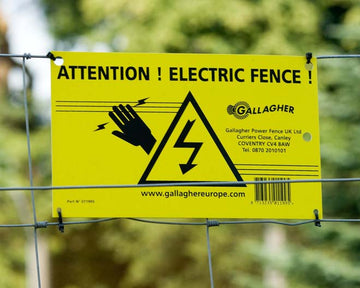Training Your Horse To Electric Fencing can be a challenge - that's why we've compiled a helpful guide for training horses that are new to the technology.
Consider the Factors

There are several things you should consider when training your horse to respect electric fencing. These factors may have an impact on what product you deem to be an adequate fencing option for your horse so keep that in mind when you are weighing the options. One of the priorities in training your horse to respect the fencing is that they can clearly see the boundary line. This is one of the reasons why barbed wire is
not a good choice for horse fencing (along with the fact that it cannot be electrified and can be dangerous).
Electric fencing options like braid fencing or the high tensile wire must be easily seen from a respectable distance considering it takes horses a longer time to slow down or to turn when they are moving at high rates of speed. Tapes or the rails are both good options for prime visibility because they are usually painted white and take up a larger part of your horse’s vision. The better the horse can see the fencing, the more they will know to avoid it.
-
Wire/Line Fencing – Generally lower visibility. Can be improved by using flags or highly visible polymer coatings.
-
Braid Fencing – Must be brightly colored to maintain optimal visibility. Again, flags are great to improve visibility.
-
Tape Fencing – Much more visible than braids. Wider variations increase visibility.
-
Rail Fencing – The most highly visible fencing. Generally stick to the brighter, white colors which look beautiful and are very easy to see. net carries some great examples of electric rail fencing.
Training
One of the most vital parts of training horses to respect electric fencing is the action of hand walking a horse around the perimeter. This allows them to see the physical boundary and to feel the heat that emanates from the electrified elements without becoming stressed about the presence of the heat. Hand walking allows for a controlled learning environment for the horse as the handler controls if the horse touches the fence and can minimize the risk of the horse becoming entangled and can reduce the amount of opportunities the horse has to develop bad behavior around the fence such as pawing and striking.
Another aspect of training a horse to respect electric fencing is to allow them ample time to grow used to the new enclosure or fenced in area. If you are bringing in a horse that has spent little time in a large enclosure, set up round pen panels in the enclosure and let the horse grow used to the expansive area for a few days. Once the horse has relaxed in the round pen, you can expand the round pen or remove it altogether and let the horse grow accustomed to the electrified fenced area.
Naturally, your horse will test the fence’s boundaries regardless of the hand walking sessions. If the shock is substantial enough, they will learn to respect the shock after a few times. They will then associate the fence with the shock and learn to stay away from the fence line. If the horse has issues with leaning on the fence and running into the fence, then it would be best to repeat the hand walking sessions as well as increasing the charge on the electrified fencing.
To learn more about safe, affordable fencing options CLICK HERE.
 There are several things you should consider when training your horse to respect electric fencing. These factors may have an impact on what product you deem to be an adequate fencing option for your horse so keep that in mind when you are weighing the options. One of the priorities in training your horse to respect the fencing is that they can clearly see the boundary line. This is one of the reasons why barbed wire is not a good choice for horse fencing (along with the fact that it cannot be electrified and can be dangerous).
Electric fencing options like braid fencing or the high tensile wire must be easily seen from a respectable distance considering it takes horses a longer time to slow down or to turn when they are moving at high rates of speed. Tapes or the rails are both good options for prime visibility because they are usually painted white and take up a larger part of your horse’s vision. The better the horse can see the fencing, the more they will know to avoid it.
There are several things you should consider when training your horse to respect electric fencing. These factors may have an impact on what product you deem to be an adequate fencing option for your horse so keep that in mind when you are weighing the options. One of the priorities in training your horse to respect the fencing is that they can clearly see the boundary line. This is one of the reasons why barbed wire is not a good choice for horse fencing (along with the fact that it cannot be electrified and can be dangerous).
Electric fencing options like braid fencing or the high tensile wire must be easily seen from a respectable distance considering it takes horses a longer time to slow down or to turn when they are moving at high rates of speed. Tapes or the rails are both good options for prime visibility because they are usually painted white and take up a larger part of your horse’s vision. The better the horse can see the fencing, the more they will know to avoid it.






















